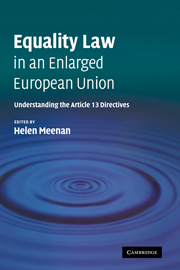Book contents
- Frontmatter
- Contents
- Preface
- Acknowledgements
- List of contributors
- Abbreviations
- Table of Cases
- PART I
- PART II
- 5 EU sex equality law post-Amsterdam
- 6 EU anti-racism policy; the leader of the pack?
- 7 Religion or belief; aiming at the right target?
- 8 Disability discrimination law in the European Union
- 9 Age discrimination – Of Cinderella and The Golden Bough
- 10 The ‘mainstreaming’ of sexual orientation into European equality law
- 11 Conclusion
- Index
11 - Conclusion
Published online by Cambridge University Press: 22 August 2009
- Frontmatter
- Contents
- Preface
- Acknowledgements
- List of contributors
- Abbreviations
- Table of Cases
- PART I
- PART II
- 5 EU sex equality law post-Amsterdam
- 6 EU anti-racism policy; the leader of the pack?
- 7 Religion or belief; aiming at the right target?
- 8 Disability discrimination law in the European Union
- 9 Age discrimination – Of Cinderella and The Golden Bough
- 10 The ‘mainstreaming’ of sexual orientation into European equality law
- 11 Conclusion
- Index
Summary
Despite the immense and historic gains since the Treaty of Amsterdam, European equality law has been beset by the rhetoric and reality of a hierarchy of protected grounds that predates the incorporation of Article 13 into the EC Treaty. The equality hierarchy has been reinforced by the three Directives adopted under Article 13 EC. However, the language of hierarchy conceals a number of underlying tensions. On the one hand there is the horizontal versus ground specific approach to non-discrimination and equality. On the other hand there is a combination of these two approaches, the idea that a common core of provisions should exist for all covered grounds with differentiation to adapt to the peculiarities of each ground. Another problem with the equality hierarchy is that it does not aid understanding of the differences between the grounds. This is so inter alia because no clear rationale has been given for the greater material and protective scope for sex and race. This volume has attempted to place the spotlight on the individual grounds against key contexts to see to what extent a greater understanding of the Article 13 Directives and their anti-discrimination grounds can be achieved. It has also attempted to move away from the equality hierarchy as the pre-eminent means of understanding the current state of equality law in the EU. Nonetheless some observations and conclusions on this paradigm are necessary to this process.
- Type
- Chapter
- Information
- Equality Law in an Enlarged European UnionUnderstanding the Article 13 Directives, pp. 342 - 357Publisher: Cambridge University PressPrint publication year: 2007

